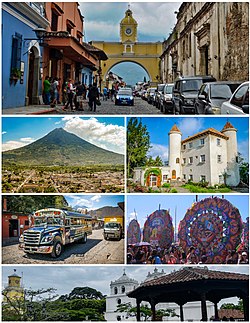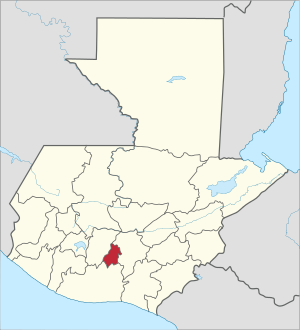You can help expand this article with text translated from the corresponding article in Spanish. (January 2023) Click [show] for important translation instructions.
|
Sacatepéquez (Spanish pronunciation: [sakateˈpekes]) is one of the 22 departments of Guatemala. The name comes from Sacatepéquez, a city from November 21, 1542, until July 29, 1773, when it was destroyed by the 1773 Guatemalan Earthquake (Santa Marta Earthquake). Sacatepéquez means grasshill in the Nahuatl language. The capital of Sacatepéquez is Antigua Guatemala. Other important cities include Ciudad Vieja and San Lucas Sacatepéquez, which also hosts a marketplace and is a culinary attraction. The Chajoma were a group of indigenous people who were Kaqchikel speaking Maya, they identified Mixco Viejo as their capital, and spread throughout the Sacatepequez Department until their capital was moved to Ciudad Vieja, in Antigua.
Sacatepéquez Department
Departmento de Sacatepéquez | |
|---|---|
 From top to bottom, from left to right: Arch of Santa Catalina, Water Volcano, Defay Castle, Traditional Chicken Bus, Sumpango giant kites and Central Plaza of the Old City. | |
 Sacatepéquez | |
| Country | |
| Capital and largest city | Antigua Guatemala |
| Municipalities | 16 |
| Government | |
| • Type | Departmental |
| Area | |
| 465 km2 (180 sq mi) | |
| Population (2018)[1] | |
| 330,469 | |
| • Density | 710/km2 (1,800/sq mi) |
| • Urban | 292,366 |
| • Religions | Roman Catholicism Evangelicalism Maya |
| Time zone | UTC-6 |
Name
editSacatepéquez has also been spelled Zacatepeques.[2]
Population
editSacatepéquez Department has a population of 330,469 (2018 census).[1] 40.2% of the population identifies as Maya, with 37.7% belonging to the Kaqchikel Maya.[3] In 1850, the area had a population of an estimated 56,000. The southern area, which is closer to Guatemala City, has the largest population.[4]
Municipalities
edit- Alotenango
- Antigua Guatemala
- Ciudad Vieja
- Jocotenango
- Magdalena Milpas Altas
- Pastores
- San Antonio Aguas Calientes
- San Bartolomé Milpas Altas
- San Lucas Sacatepéquez
- San Miguel Dueñas
- Santiago Sacatepéquez
- Santa Catarina Barahona
- Santa Lucía Milpas Altas
- Santa María de Jesús
- Santo Domingo Xenacoj
- Sumpango
Geography
editThe area is mountainous, with what the British described, in 1850, as a "mild climate."[2] Guatemala hosts a chain of active and dormant volcanoes, with those in Sacatepequez including Acatenago, Volcan De Agua (Volcano of Water), and Volcan de Fuego (Volcano of Fire).[5] Jocotes, a fruit of the cashew family, grow in the region.[6]
Economy
editThe more populated areas produce fruit and various crops, including maize. Livestock is also raised, with trade going towards Guatemala City. The southern area of the department produces coffee, sugar, tobacco, and cotton. As of 1850, products were being shipped out of Iztapa.[4] Although Guatemala is able to produce cash crops such as bananas and textiles, 72% of people living in rural areas live in poverty with 31% of them reaching extreme poverty.[7]
Culture
editArt
editSacatepéquez is also home to the National Museum of Guatemalan Art, which is located in Antigua Guatemala.[8][9]
See also
editReferences
edit- ^ a b Citypopulation.de Population of departments in Guatemala
- ^ a b Baily, John (1850). Central America; Describing Each of the States of Guatemala, Honduras, Salvador, Nicaragua, and Costa Rica. London: Trelawney Saunders. p. 76.
- ^ "Censo 2018". 2018.
- ^ a b Baily, John (1850). Central America; Describing Each of the States of Guatemala, Honduras, Salvador, Nicaragua, and Costa Rica. London: Trelawney Saunders. p. 77.
- ^ Landmeier, Phillip. "The Volcanos of Guatemala". www.mayaparaiso.com. Retrieved 2017-05-10.
- ^ "Guatemala's "National Fruit" – The Jocote - Qué Pasa Magazine". www.quepasa.gt. Retrieved 2017-05-10.
- ^ Huber-Warring, Tonya (2008-01-01). Growing a Soul for Social Change: Building the Knowledge Base for Social Justice. IAP. ISBN 9781593118877.
- ^ "Museo Nacional de Arte de Guatemala MUNAG – SIC". www.sicultura.gob.gt. Retrieved 2024-01-04.
- ^ Contreras, Pamela (2023-11-11). "For the First Time Ever: Government Creates a National Art Museum of Guatemala | GTNews - Guatemalan News Agency". Retrieved 2024-01-04.
External links
edit- Media related to Sacatepéquez Department at Wikimedia Commons
14°33′24″N 90°44′02″W / 14.5566666667°N 90.7338888889°W

